1 December. Locusts shift from summer to winter breeding areas
Low numbers of Desert Locust adults have moved from the summer breeding areas of southern Mauritania to the northwest where small-scale breeding could occur if more rains fall. Small populations of scattered adults are present in parts of the central and southern Sahara in Algeria. Residual hopper and adult populations from summer breeding persist in parts of Tamesna, Niger, in eastern Chad and probably in northern Mali but insecurity prevented ground surveys from being undertaken. Locust numbers will decline in the northern Sahel as vegetation continues to dry out, and only a few adults are likely to persist.
In Sudan, a similar movement occurred from the summer breeding areas in the interior to the Tokar Delta on the Red Sea coast where breeding will commence with the onset of the rains. Small-scale breeding is in progress on the Red Sea coast in Saudi Arabia near Qunfidah and this may extend to other coastal areas, including Yemen, once more rains fall.
Unusually heavy rains fell over a 1,000 km stretch of coastline in southeast Oman which could lead to small-scale breeding if temperatures remain warm.
No locusts are present in Southwest Asia.
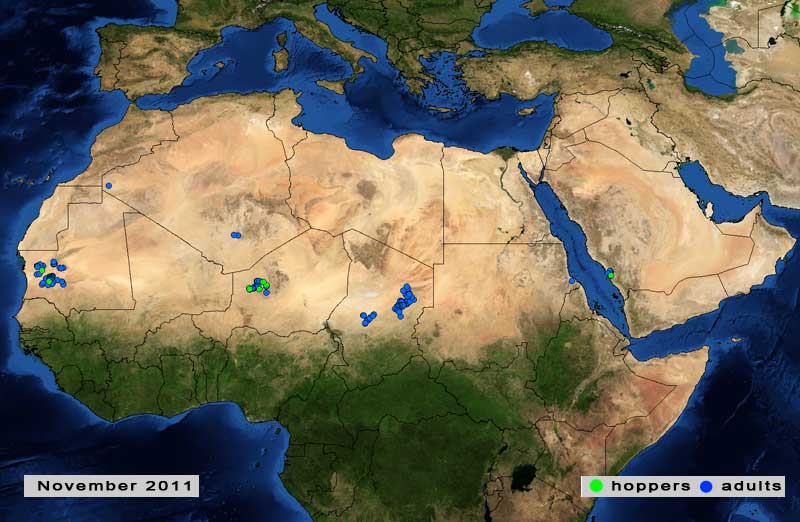
Low numbers of adults move from summer to winter breeding areas.
3 November. Locust numbers remain low due to unusually poor rainfall
The Desert Locust situation remains calm in all countries. Locust numbers are lower than normal due to poor rainfall in the summer breeding areas from West Africa to India during the past few months. Nevertheless, small-scale breeding occurred in western Mauritania and on the coast of Pakistan. Scattered adults are present in western Mauritania, northern Mali and Niger, eastern Chad, northern Sudan, and in Pakistan.
In the Western Region, locust adults will move from the summer breeding areas of southern Mauritania to the northwest of the country where higher than normal rains may occur during November. If so, then small-scale breeding will take place and cause locust numbers to increase. Scattered adults could appear in adjacent areas of Western Sahara. Low numbers of adults may persist in parts of northern Mali, Niger and eastern Chad.
In the Central Region, low numbers of adults will appear in the winter breeding areas along the Red Sea coast of Sudan and Eritrea as they arrive from the summer breeding areas of the interior. Small-scale breeding will occur with the onset of the rains. Small-scale breeding may also commence on the Red Sea coastal plains of Yemen and in adjacent areas of Saudi Arabia.
In the Eastern Region, locust numbers will continue to decline along the Indo-Pakistan border but there remains a low risk of possible breeding in the Tharparkar Desert where floods occurred in August and September. A few adults may appear in Baluchistan, Pakistan.
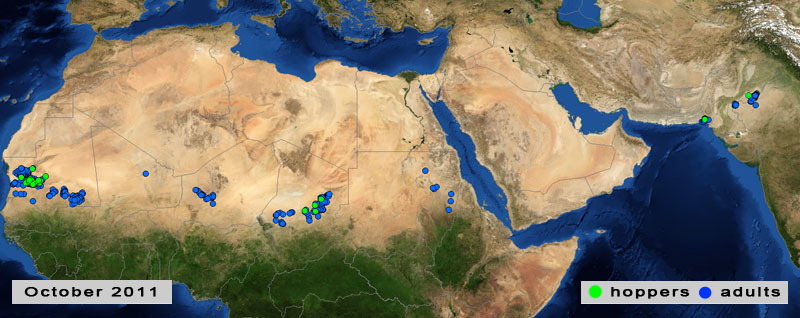
Locust situation in October 2011.
3 October. Poor rains in the northern Sahel of Africa limit summer breeding
Seasonal rains in the northern Sahel in Mauritania, Mali, Niger and Sudan were generally poor during September, causing ecological conditions to be less favourable than normal for breeding in most areas. Consequently, only limited breeding occurred and Desert Locust numbers remained low. On the other hand, good rains fell in the northern Sahel of Chad and in the western lowlands of Eritrea where ecological conditions are favourable and small-scale breeding is likely to be in progress in parts of both countries. It is hoped that surveys will confirm this in a few weeks.
During October, locust adults are expected to start shifting from southeast Mauritania to the west and northwest (Trarza and Inchiri). In Mali and Niger, locusts are likely to concentrate in any vegetation that remains green. Locusts will also start to shift from the interior of Sudan and from western Eritrea to the Red Sea coast.
Good rains fell throughout last month on the Red Sea coast of Yemen and in adjacent areas of Saudi Arabia. Small-scale breeding is probably underway in Yemen but surveys could not confirm this due to current insecurity.
In Southwest Asia, very heavy rains and floods occurred in early September in southeast Pakistan for the second consecutive month. Once floodwaters recede, breeding conditions are expected to remain favourable for a number of months and much longer than in most years. Only low numbers of adults and limited breeding is underway along both sides of the Indo-Pakistan border in Cholistan, Pakistan and Rajasthan, India. The monsoon rains declined after 20 September.
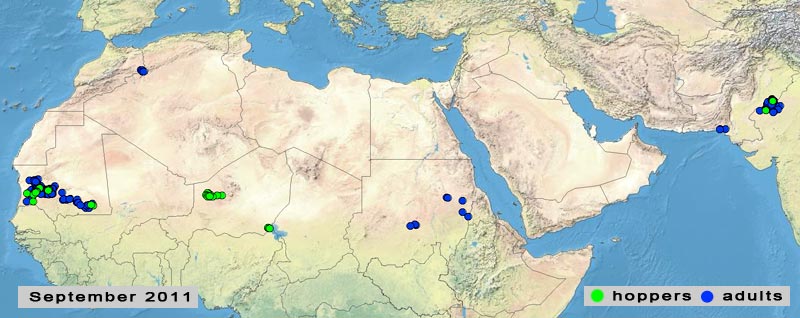
Locust situation in September 2011.
2 September. Small-scale breeding in the northern Sahel of West Africa
The Desert Locust situation remains calm in all countries.
So far, seasonal rains have been quite good in most of the summer breeding areas that stretch across the northern Sahel from Mauritania to western Eritrea, in the interior of Yemen and along both sides of the Indo-Pakistan border.
Low numbers of adults have been detected in parts of Mauritania, northern Mali, western and northern Niger, northern Sudan and along both sides of the Indo-Pakistan border.
Small-scale breeding is underway in parts of the summer breeding areas in West Africa, primarily in southwest and central Mauritania and western Niger. It is also likely to be in progress in southern Mauritania, northern Mali, eastern Chad, the interior of Sudan, in western Eritrea and perhaps in the interior of Yemen. This will continue and cause locust numbers to increase in all areas during September.
Regular surveys are recommended in all areas to monitor the situation and detect any significant increases in locust numbers.
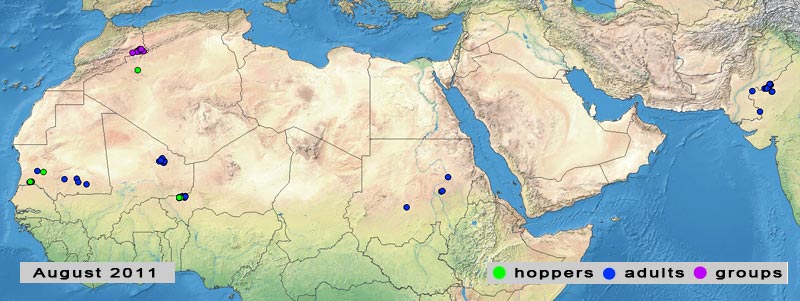
Locust situation in August 2011.
3 August. Low numbers of adults appear in the summer breeding areas
Low numbers of solitary Desert Locust adults appeared in the summer breeding areas of the northern Sahel in southern and central Mauritania, northern Niger and northern Sudan during July. Similar numbers are likely to be present in northern Mali, in parts of eastern Chad, the western lowlands in Eritrea and in the interior of Yemen north of Wadi Hadramaut. Ground surveys remain difficult to undertake in some areas due to continued insecurity. During August, small-scale breeding will occur in areas of recent rainfall and cause locust numbers to increase further in these countries.
In Northwest Africa, ground control operations were carried out against hopper and adult groups that arose from local breeding in Western Sahara, central Algeria and northeast Morocco. Any adults that remain are expected to move south to the summer breeding areas in the northern Sahel.
In Southwest Asia, solitary mature adults appeared in the summer breeding areas along both sides of the Indo-Pakistan border mainly in Cholistan, Pakistan and to a lesser extent in Rajasthan, India. Small-scale breeding during August will cause locust numbers to increase.
Locust situation in July 2011.
Desert Locust infestations declined during June in Africa, the Near East and Southwest Asia due to ongoing control operations and drying vegetation.
In the Central Region, ground teams treated residual infestations on the Red Sea coast in Saudi Arabia. There were no reports of locusts moving into the interior of the country or into Yemen but scattered adults appeared in the summer breeding areas of northern Sudan. Seasonal rains commenced in some places but generally remained south of the locust breeding areas.
In the Eastern Region, a small swarm was treated in southeast Iran and ground teams treated local infestations in western Pakistan. Scattered adults appeared in the summer breeding areas along both sides of the Indo-Pakistan border. Hoppers were seen in Jaisalmer District of India but these may be grasshoppers. Monsoon rains reached Rajasthan by the end of June.
In the Western Region, local infestations were treated in Algeria and the Western Sahara. Seasonal rains commenced in some of the summer breeding areas of the northern Sahel from Mauritania to central Chad. Scattered adults appeared on the Tamesna Plains in Niger.
During July, more adults will appear in the summer breeding areas in all regions. Small-scale breeding will cause locust numbers to increase but remain below threatening levels for this generation.
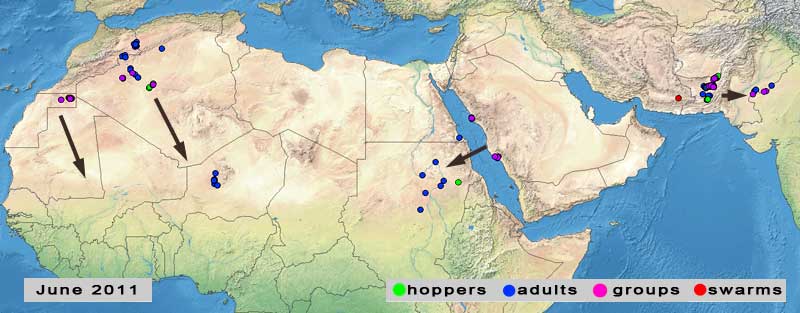
Locust situation in June 2011.
Significant Desert Locust infestations persisted during May on the central Red Sea coast in Saudi Arabia near Lith and Jeddah. Ground and aerial teams continued control operations in all infested areas, treating nearly 25,000 ha in May which was nearly double the area treated in April. It is expected that continuing operations will contain current infestations. However, any adults that are not detected or controlled will concentrate in the little vegetation, including cropping areas, that remains green and will form small groups and perhaps a few small swarms. As vegetation is drying out rapidly, the adult groups and swarms will move off the coast to the summer breeding areas in the interior of Yemen during this month.
The adults, groups and perhaps small swarms will most likely arrive at any time during June in the Yemen interior east of Sana'a from Marib and Al-Jawf to Sayun and Thamud in the Shabwa and Hadhramaut regions. If good rains fall in any of these areas, then the situation will deteriorate further as at least one generation of breeding will occur, causing locust numbers to increase significantly. From July onwards, the risk and threat of movement from Saudi Arabia will diminish.
FAO DLIS fully understands that the current events in Yemen do not readily permit thorough and effective survey and control operations in the field. Nevertheless, any activities that can be undertaken in the interior during June will contribute to early warning and response in the Region as part of Desert Locust preventive control strategy.
Elsewhere, the situation remains relatively calm. Control operations declined in northwest Mauritania and southeast Egypt but were undertaken in the spring breeding areas in southeast Iran and western Pakistan. Smaller operations were carried out in Western Sahara and near Adrar, Algeria. During June, scattered adults will appear in the summer breeding areas of the northern Sahel in Mauritania, Mali, Niger and Chad. Small groups or swarms may appear from Saudi Arabia in the summer breeding areas of northern Sudan.
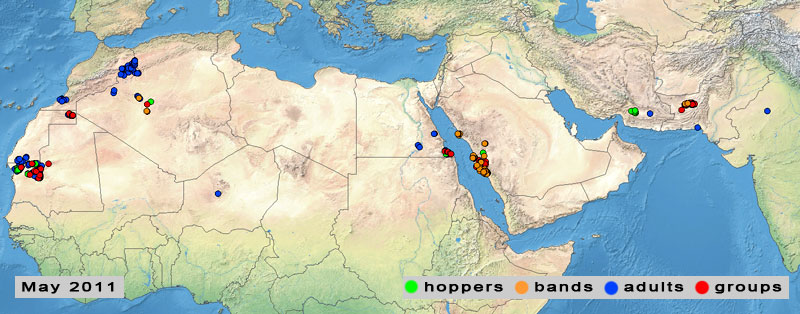
Locust situation in May 2011.
3 May. Locust populations slowly declining but control operations continue
Desert Locust infestations are declining on the Red Sea coast in Sudan and Egypt due to drying conditions and recent control operations. Nevertheless, scattered adults and perhaps a few small groups could move west into the interior of northern Sudan and southern Egypt during May.
In Saudi Arabia, aerial and ground control operations continue against hopper bands and groups of hoppers and adults on the Red Sea coast between Lith and Umm Lajj. Control teams treated some 13,000 ha in April compared to 29,000 ha for March, suggesting that the situation is improving. However, more bands could form from hatching during May. As vegetation dries out on the coast, adults will form groups and perhaps a few small swarms that could move in May to the interior and lay eggs in areas of recent rain southwest of Riyadh. In June, the risk is higher of adults crossing the Red Sea to the summer breeding areas in northern Sudan.
In Northwest Africa, locust infestations will decline in northwest Mauritania and in the southern part of Western Sahara in Morocco due to control operations, drying vegetation, and as adults move to the summer breeding areas in the south of the country. This year, somewhat higher than normal numbers are expected to appear prior to the rainy season.
In Southwest Asia, small-scale breeding is underway in the Baluchistan interior of western Pakistan and southeast Iran. Locust numbers will increase slightly in May then decline in June as adults move towards the summer breeding areas along both sides of the Indo-Pakistan border.
Therefore, all efforts should be made to control current infestations in the above regions in order to reduce migration to the spring and summer breeding areas.
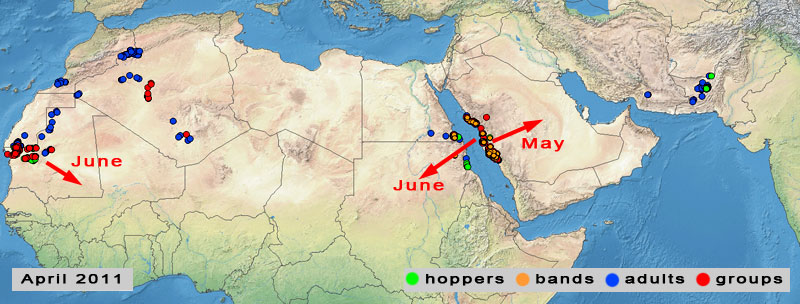
Locust situation in April 2011.
4 April. Control operations continue in several key countries to prevent spring migration
Important Desert Locust infestations are present in Sudan, Saudi Arabia, Egypt and Mauritania as a result of continued breeding. The most serious infestations have been reported on the Red Sea coast in Saudi Arabia where substantial aerial and ground control operations are underway against hopper bands and swarms. Control operations are also in progress in southeast Egypt. On-going control operations in northwest Mauritania and on the Red Sea coast in Sudan recently began to decline. Smaller scale operations have taken place in southern Morocco and Algeria. More than 40,000 ha were treated in March of which nearly 30,000 ha were in Saudi Arabia.
Elsewhere, low numbers of adults are present in northern Niger, on the Red Sea coast in Yemen, on the northern coast in Oman, and in the spring breeding areas in western Pakistan.
If the remaining infestations in Saudi Arabia are not controlled, new adult groups and small swarms could form on the coast and move into the interior during April. From early May onwards, there is an increased risk that locusts could cross the Red Sea to Sudan. In Northwest Africa, adults and small groups in northwest Mauritania and southern Morocco could move to the southern side of the Atlas Mountains in Morocco and Algeria and lay eggs.
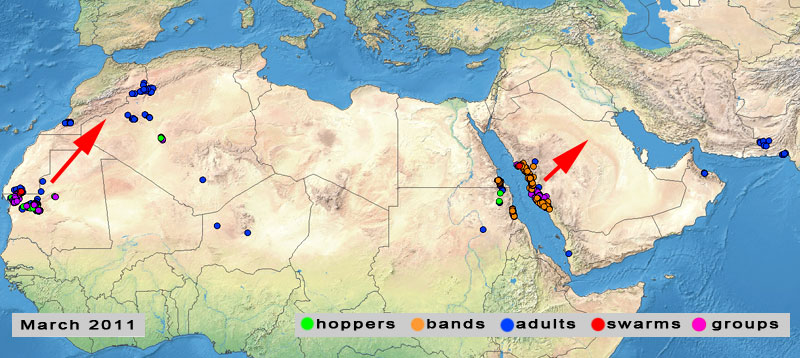
Locust situation in March 2011.
3 March. Control operations continue in Saudi Arabia, Sudan and Mauritania
The Desert Locust situation continues to remain serious in the winter breeding areas along both sides of the Red Sea in Sudan and Saudi Arabia. Ground and aerial control operations are in progress in both countries. In Sudan, teams are treating small hopper and adult groups, hopper bands and adult swarms on the central coast and, to a lesser extent, in the Tokar Delta and in Wadi Oko/Diib. In Saudi Arabia, some 54 teams and two aircraft are involved against hopper bands that formed in February on the Red Sea coast between Qunfidah and Yenbo. Smaller scale ground control was undertaken recently in southeast Egypt.
In Sudan, more hatching is expected during the first half of March. As vegetation dries out, locusts will concentrate and form groups, bands and a few small swarms. There is a moderate risk that a few groups and swarms could appear in the Tokar Delta or cross the Red Sea.
In Saudi Arabia, small groups of adults and swarms will form in March that, if not controlled, are likely to move into the spring breeding areas of the interior if no further rains fall on the coast.
The situation is improving in northwest Mauritania due to on-going control operations and drying vegetation. Nevertheless, hatching will continue during the first half of March in parts of Inchiri, Adrar, Dakhlet Nouadhibou, and hoppers and adults are likely to form small groups. There is a low to moderate risk that some groups could reach the spring breeding areas along the southern side of the Atlas Mountains in Morocco in March.
All efforts are required to control current infestations in order to reduce migration to the spring breeding areas.
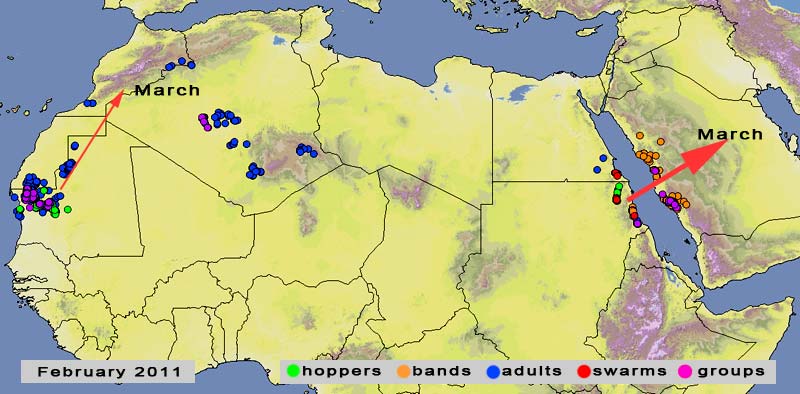
Locust situation in February 2011.
2 February. Control operations in progress in Sudan, Saudi Arabia and Mauritania
The Desert Locust situation remains serious in the winter breeding areas along the Red Sea coastal plains in Sudan and Saudi Arabia. Hatching has caused locust numbers to increase in both countries and hoppers are forming groups and bands. Aerial and ground control operations are in progress in Sudan and ground control operations are underway in Saudi Arabia. More hatching is expected in both countries in the coming week or so. If current infestations are not controlled, new groups of adults and perhaps a few small swarms will form that could move to the spring breeding areas in the interior of Saudi Arabia. Smaller infestations are present in adjacent areas of southeast Egypt. Local breeding is underway on the Red Sea coast of Yemen where locust numbers remain low.
In the Western Region, breeding is continuing in northwest Mauritania and ground control teams are treating groups of hoppers and adults. Some infestations have extended into the southern part of Western Sahara in Morocco. There is a moderate risk that adults and some adult groups will move north to the spring breeding areas along the southern side of the Atlas Mountains in Morocco and Algeria in the next month or so.
All efforts should continue to monitor the potentially dangerous situation carefully and to undertake control operations as necessary.
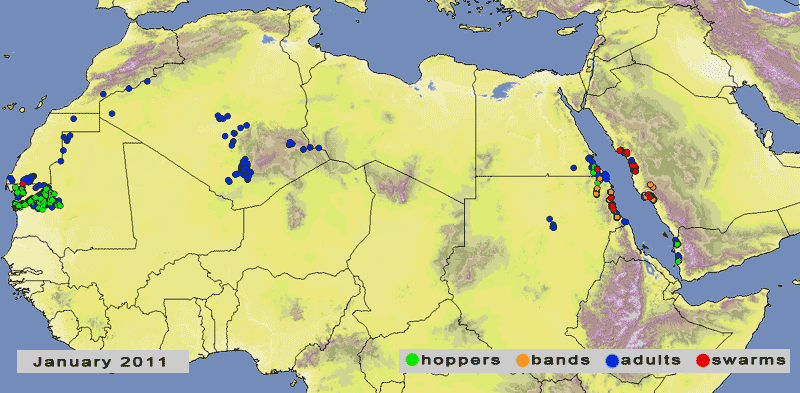
Locust situation in January 2011.
14 January. Aerial and ground control operations in progress on Red Sea coast in Sudan
The Desert Locust situation remains serious in northeast Sudan and has spread into adjacent areas of southeast Egypt.
During the second week of January, a small medium dense swarmlet and groups of mature adults were seen copulating on the Red Sea coast in southeast Egypt near Shalatein. Ground teams treated 100 ha. The infestations are present near the mouth of Wadi Diib which starts in northeast Sudan and drains the western side of the Red Sea Hills. Scattered mature adults are also present on the coast near Halaib and the border of Sudan.
In northeast Sudan, aerial and ground control operations are in progress against hopper bands of all instars in Wadi Diib/Oko and on the coast between Suakin and Mohamed Qol. Two breeding swarms were also treated on the coast. More than 1,700 ha were sprayed in the first week of January. Groups of solitarious and gregarious adults are laying eggs in Wadi Diib and on the central coast. In the Tokar Delta, groups of late instar hoppers and adults are present. Breeding is expected to continue during January in Wadi Diib, on the central coast, and in the Tokar Delta.
Elsewhere, ground teams treated more than 9,000 ha during the first decade of January in northwest Mauritania (Inchiri, Adrar and Dakhlet Nouadhibou regions) where groups of immature and mature adults are present mixed with local concentrations of hoppers. Small-scale breeding will continue during January. Lower numbers of adults are present further north in Tiris Zemmour.
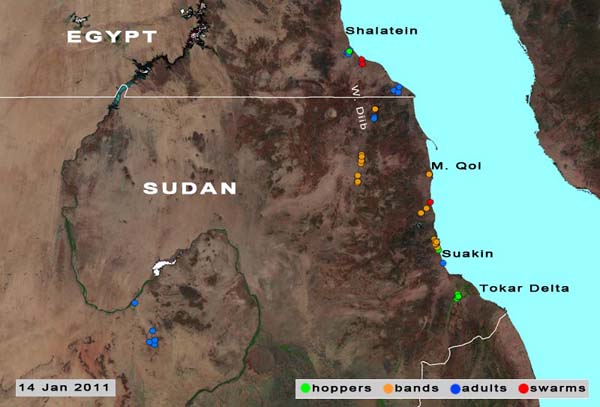
Control operations in NE Sudan.
4 January. Hatching and hopper band formation on the Red Sea coast in Sudan
The Desert Locust situation remains serious in the winter breeding areas of Sudan. Hatching and hopper bands are forming in the northeast, primarily in Wadi Diib just south of the Egyptian border, and on the central Red Sea coast. Smaller scale breeding is underway in the Tokar Delta. Ground and aerial control operations are in progress.
Elsewhere in the winter breeding areas along both sides of the Red Sea, small scale breeding is in progress in southeast Egypt adjacent to the infestations in Sudan. Small hopper groups and bands are forming on the northern Red Sea coast in Yemen and ground control operations are in progress. Egg laying has occurred along parts of the coast in Saudi Arabia.
Locust numbers will increase during January primarily in Sudan and to a lesser extent in Egypt, Saudi Arabia and Yemen. The situation remains unclear in Eritrea where surveys have not been undertaken.
Small hopper and adult groups are present in northwest Mauritania and limited control operations are underway. Low numbers of adults are present in Western Sahara and Algeria.
Locust infestations declined along both sides of the Indo-Pakistan border as a result of control operations, drying conditions and emigration to the spring breeding areas in western Pakistan.
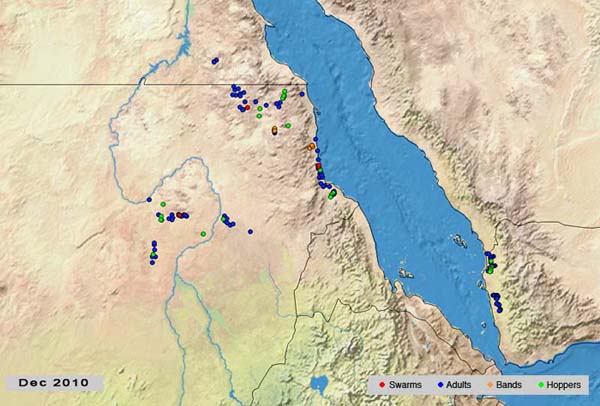
Locusts increase in NE Sudan.





